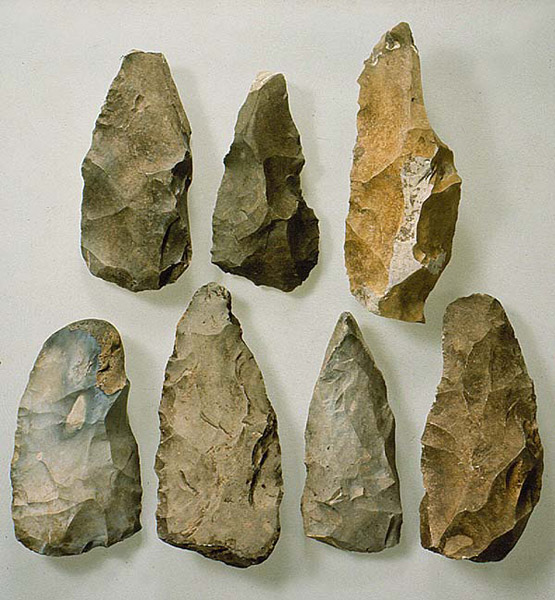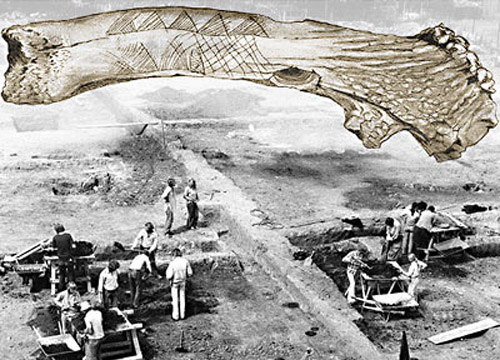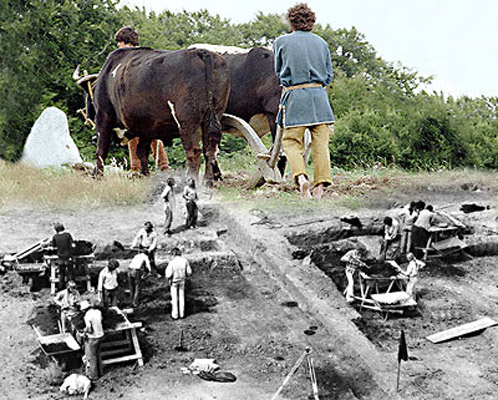| Stenalderen

| | Stenalderen er betegnelsen for perioden ca. 12.000 f.Kr. til peroden ca. 1800 f.kr.
Den lange periode deles ofte op i ældre og yngre stenalder.
Flinten var det mest benyttede arbejdsredskab og våben.
Flintøksefundene er oftest fra yngre stenalder. Foto: Fotevik Museum |
Ældre stenalder

| | Den ældre stenalder strækker sig fra ca. 12.000 år f.Kr frem til ca. 4.000 år f.Kr.
Kendetegnende for perioden er, at der levede et relativt begrænset antal mennesker i Øresundsregionen samt at disse mennesker ikke var bofaste i den betydning, at de dyrkede jord. |
Indledning
Den ældre stenalder strækker sig fra ca. 12.000 år f.Kr. frem til ca. 4.000 år f.Kr. Kendetegnende for perioden er, at der levede et relativt begrænset antal mennesker i Øresundsregionen, og at disse mennesker ikke var bofaste og dyrkede jord.
Under denne tidsperiode forandredes både klimaet og naturen i Skandinavien. De første jægerfamilier mødte et arktisk klima med et tundralignende landskab, medens familierne under periodens senere del levede i store og tætte skove fyldt med vilde dyr.
Nogle af de ældste spor efter mennesker i Øresundsregionen er de stenalderfund, der blev gjort ved Mölleröd tæt ved Finjasøen i det nordlige Skåne. Her har rensdyrjægere efterladt sig bearbejdet flintsten især i form af pilespidser.
Et andet fund fra vores ældste forfædre kommer fra Segebro i Malmøs nordlige udkant. Denne boplads er dateret til ca. 8.300 f. Kr.
Segebro
Segebro ligger i Malmøs nordlige udkant. I en kortere periode har én eller flere rensdyrjæger-familier ca. 8000 f.Kr. slået sig ned her for at jage. De har efterladt sig et stort antal bearbejdede flintsten, som har været benyttet til forskellige redskaber. Det har ikke været nogen stor lejrplads, men man har fundet spor efter et stort telt.
Man har også fundet to steder, hvor renjægerne har siddet og flækket flintstene til skrabere, knive og pilespidser. Her lå dynger af halvfærdige redskaber. Med runde slagstene har man slået fliser –spån- ud af større flintblokke. Disse aflange spån har man herefter bearbejdet yderligere. En del er blevet til kraftige spidser, der har kunnet anvendes til våben. Andre har fået en skarp kant, så de kunne bruges som skrabere.
Disse første Malmøboere var nomader. Dyrene, man jagede, udgjorde selve livsgrundlaget. Af rensdyr og elge, fik man kød, men også skind til klæder, telte, transportemballage og meget mere. Dyrenes sener blev til sytråd; knogler og horne blev til arbejdsredskaber. Teltene var af dyrehuder; kvinderne tilberedte det kød, som mændene efter vellykkede jagter slæbte hjem til lejren. Med flintredskaberne bearbejdede man huder, træ og dyrenes horn og knogler.

Segebro |
Bopladser under vandet
I den ældre stenalder var vandstanden i det sydlige Skandinavien betydeligt lavere end i vore dage. Dette forklarer f.eks. hvorfor der står mængder af fyr-træstubbe dybt nede på Østersøens bund. Bornholmske fiskere har i hele 1900-tallet fået træstubbe fra både 30 og 80 meters dybde i deres net; et klart bevis på, hvor lavt vandoverfladen en gang stod. Øresund var, under det meste af den ældre stenalder, kun et smalt vandområde med en række større og mindre øer.
Temperaturen stiger og isen smelter:
I forbindelse med at temperaturen, globalt set, steg, smeltede store ismasser og verdenshavenes overflade steg. I perioden 7.500 f. Kr. til ca. 6.000 f.Kr. steg Øresunds vandoverflade således med 15 meter. For, godt og vel, syvtusinde år siden stod vandoverfladen på nutidens niveau.
Men vandstanden steg yderligere til næsten tre meter over nutidens niveau i Øresund. Efterhånden trak vandet sig tilbage og dannede den kystlinie, vi kender i dag.
På Øresunds bund findes der derfor adskillige stenalder-bopladser.
Fundet ved Limhamn:
Et eksempel på en sådan jægerstenalder-boplads er fundet fra Limhamn. Da man gravede mudder op ved Limhamns havn i 1891, fulgte der både græstørv og bearbejdet flint med. Bl.a. 13 stenøkser.
Fundet kom fra boplads fra 5000 f Kr. på to-tre meters dybde under Øresunds nuvarende vandoverflade.
Fundet ved Hven:
En anden ”underjordisk” boplads i Øresund er fundet nær øen Hven. På det nærliggende fastland, lidt syd for øen, ligger byen Landskrona, hvor en å, Saxåen, i dag løber ud i Øresund. Da vandet i Øresund stod langt lavere end i dag løb åen ud ved Hven. Af denne tidligere å ser man i dag en dyb rende på bunden af Øresund.
Ved at undersøge å-ravinens sider har dykkere kunnet spore flere skjulte bopladser. En af disse ligger på grunden Pilhaken.
Fra et bundniveau syv meter under vandoverfladen går den tidligere å-ravine stejlt nedad til 14 meters dybde. På ravinens kanter fandt arkæologerne rester efter en boplads. De forskellige overleveringer lå søbet ind i et tykt lag af slam. Der var tale om mængder af flintafslag, flintskrabere og andre flintredskaber. Knogler fra urokse, kronhjort og rådyr viste, at disse vore tidlige forfædre, ikke blot ernærede sig ved fiskeri.
Fundet ved Espergærde, Nordsjælland:
Umiddelbart foran Egebæksvang Kirke på Strandvejen i Espergærde har dykkere i nyere tid observeret en boplads under havoverfladen.

Egestamme |
Skateholm og Vedbæk
I Skateholm ved Skånes sydkyst, lige øst for Trelleborg, findes en af de største kendte bosættelser i Sydskandinavien fra den yngste del af den ældre stenalder, ca. 5.600 f. Kr. til ca. 4.700 f. Kr.
Udover spor efter enkle hyttekonstruktioner har man fundet en mængde grave. Bopladsen er nogenlunde samtidig med den boplads, som danske arkæologer afdækkede i Vedbæk på den danske side af Øresund.
Tilsammen giver disse to bopladser en uvurderlig information om datidens mennesker og deres livsvilkår.
Vedbækfundet er udstillet på G. Holtegård, Sjælland, mens Skateholmsfundet kan beses på Trelleborg Museum, Skåne.

Skateholm I | 
Skateholm II | 
Rekonstruktion af hytte |
Bergmandsdal ved Helsingør
I 1955 opdagede en husejer på Sdr. Strandvej 52. d, syd for Helsingør, spor efter en af Øresundsregionens mange bopladser fra ca. 5.000 år f. Kr.
Arkæologiske udgravninger på fundstedet afdækkede bl.a. tre menneskeskeletter, fem hundeskeletter og en del flintøkser, hjortetaksøkser og skafter til disse af samme materialer. Både hjortetaksøkserne og skafterne var smykkede med geometriske mønstre, som var fælles for jægergrupperne i Sydskandinavien.
Af det samlede fund fremgår det, at stenalderjægerne på stedet har levet af fiskeri og jagt i de store bagvedliggende skove. I skovene har de jagtet hjortevildt, svin, pelsdyr og fugle.

Hjortetaksøkse | 
Ornament på øksen | 
Hjortetaksskaft |
Yngre stenalder

| | Dette tidsafsnit af vores nordiske fortid strækker sig fra ca. 4.000 f. Kr. frem til ca. 1.800 år f. Kr.
Agerbruget blev langt mere almindeligt, og bopladserne mere permanente. |
Indledning
Dette tidsafsnit af vores nordiske fortid strækker sig fra ca. 4.000 f. Kr. frem til ca. 1. 800 år f. Kr.
Kendetegnende er, at agerbruget vandt frem og befolkningen blev derfor mere bofast end tidligere; hermed skete der også en ændring af måden menneskene levede og boede sammen på. Arbejdsredskaberne, flintøkserne, forandredes og nye opbevaringsmåder blev nødvendige, f.eks. keramikkrukkerne. I stedet for en befolkning, der fortrinsvis levede af jagt og fiskeri, blev det nu afgrøderne fra det voksende jordbrug, der kom til at blive det bærende eksistensgrundlag. Perioden kaldes derfor også, med rette, for Bondestenalderen.
Bondestenalderen deles normalt op i tre tidsafsnit, som arkæologerne betegner:
-Tidligneolitikum
-Mellemneolitikum
-Senneolitikum
Megalitgravene/Storstensgravene
Periodens gravskikke betyder bl.a., at der i Øresundsregionens kulturlandskab endnu er markante spor efter disse tidlige og driftige bønder i form af storstensgrave. De såkaldte dysser og jættestuer. Tilsammen kaldes de for megalitter.
I dagens Danmark kendes omkring 6.000 stendysser og 700 jættestuer, men ofte er det dog kun resterne af dem, man kan se.
Kvalificerede beregninger anslår, at der oprindeligt har været 20-25.000 af disse megalitter i perioden 3.500-3.200 f.kr..(Jf. Odense Museum)
Traditionelt daterer man normalt stendysserne til tidlig neolitikum og jættestuerne til mellemneolitikum, men de to megalitter hører dog uløseligt sammen.
Storstensgravene blev i flere hundrede år benyttet først som enkeltmandsgrave (til Høvdinge?) og senere som lokalområdets fælles gravplads.
Langhøje
En speciel type af grave, de såkaldte ”langhøje” var en slags forløbere for det egentlige dyssebyggeri. De er dateret til den ældste del af bondestenalderen - altså den del, der betegnes som tidlig-neolitikum.
Langhøjene kan virke meget imponerende, selvom højden ofte kun er nogle få meter. Bredden er under 10 meter, men længden kan være ganske betydelig. Langhøjene er de første monumentale fortidsgrave over jordlaget, som vi kender. Til forskel fra de senere langdysser er selve gravkammeret ikke opbygget af sten, men af træ. Det som udefra kendetegner en langhøj er imidlertid, at hele det aflange, rektangulære gravområde er afgrænset af oprejste sten/randstene.
Et eksempel på en sådan langhøj er den såkaldte ”Jättegrav” ved Trelleborg i Skåne. Her er der ca. 60 stene omkring gravområdet tilbage, men i stenalderen har der ganske givet været mindst det dobbelte. Graven er kun ca. fem meter bred, men er til gengæld hele 64 meter lang. Dette gør den til den største af sin slags i Sverige.
Runddysser
Dysser er stenkammergrave, hvor man på store støttesten placerer en større stenblok. Blandt dysserne skelner man –alt efter form- mellem runddysser og langdysser. Mellemrummene mellem de store sten har man udfyldt med mindre sten lagt oven på hinanden.
I nutiden ser man ofte dysser, som er helt fritstående. Sådan var det ikke i fortiden. Da lå disse gravkamre næsten helt skjult under et lag af opkastet jord.

Skegridyssen | 
Gantoftedyssen | 
Dysse ved Höör i Skåne | 
Klosterris Hegn i Nordsjælland |
Langdysser
Ofte dannede højens kanter en kvadratisk platform markeret med randstene. Resterne efter en langdysse er bl.a. gravet ud i Fosie udenfor Malmø. I 1980´ erne blev den rekonstrueret i Skånes Dyrepark tæt ved Höör i midten af Skåne.
I Nordsjælland, ved Trollesminde tæt ved Hillerød, fandt man i 1855 en af Danmarks største langdysser: ”Rokkestenen”. Langdyssen er 40 meter lang og 25 meter bred og består af et kisteformet gravkammer, som er omkranset af en række randsten, hvoraf nogle af dem er ca. to meter høje. Taget på langdyssen, dækstenen, måler ca. to gange tre meter og vejer skønsmæssigt 12-14 tons.
Under udgravningen af den kolossale dæksten opdagede man, at stenen kunne rokkes frem og tilbage. Således fik ”Rokkestenen” sit navn.
Hillerød Kommune har i 2007 i samarbejde med Nationalmuseet ryddet området omkring fortidsmindet, så man på marken mellem Peder Oxes Allé og motortrafikvejen kan glæde sig over synet.

Langdysse ved Hillerød |
Jættestuer
Jættestuerne er et rektangulært eller ovalt gravkammer ofte benyttet som kollektiv gravplads. De er opført inden for et relativt kort tidsafsnit og hører i Danmark tidsmæssigt til omkring mellemnolitimun ca.3.200 f.Kr.
Jættestuerne er en arkitektonisk videreudvikling af dysserne forstået på den måde, at selve gravkammeret nu er vældig stort og har flere dækstene. For at komme ind til gravkammeret skal man igennem en 4-6 meter lang og trang gang. Der findes desuden jættestuer med to gravkamre.
På den skånske side af Øresund findes to velbevarede jættestuer, dels ved Barsebäck, dels ved Ålabodarna. Begge disse stenaldergrave kan man krybe ind i. Husk at tage en lommelygte med!
På den danske side af Sundet findes der, bl.a. ved Roskilde, en velbevaret jættesstue, hvor der er adgang året rundt. Og i skovene og på markerne i Helsingør Kommune er der mange, mere eller mindre, velbevarede spor efter både dysser og jættestuer.

Jættestuen i Gillhög |
Flintøkser
Flintøksen er et redskab, som i allerhøjeste grad forbindes med bondestenalderen. Det krævede kraftige økser at fælde de store træer, først og fremmest løvtræer, der godt 3.000 år f. Kr. dannede store og tætte skove i landskabet.
Kerneøkserne
Man kendte godt til flintøkser i jægerstenalderen, men disse var lette og kunne ikke benyttes til at fælde store træer med. Jægernes flintøkser var såkaldte ”kerneøkser”, som var temmelig groft formet og tilhugget fra en mindre, aflang flintsten. Man havde også såkaldte ”skiveøkser”, som man skabte ved at spalte en større flintblok.
De spidsnakkede økser
Under tidligneolitisk tid, ca. 3.900 f.Kr. – ca. 3.300 f.Kr., begyndte de slebne flintøkser at dukke op i Sydskandinavien. Først kom de såkaldte ”spidsnakkede” økser. Øksetypen er fundet i store mængder just i Skåne og på Sjælland. Allerede i slutningen af 1800-tallet påpegede den legendariske svenske arkæolog Montelius, at denne type var den ældste af de ældste slebne flintøkser. Den spidsnakkede økse var helslebet og jævnt tilspidset mod nakken. Den har ingen smalle sider, øksens to hvælvede sider møder i stedet hinanden i en skarp kant.
De tyndnakkede økser
I mellemneolitisk tid dukker der en helt ny type af flintøkser op. De er ofte betydeligt større og frem for alt længere. De kaldes for ”tyndnakkede”. De er flade og smaller ind mod nakken. Længden kan variere fra 15 cm. og helt op til 40 cm.
Forandringen af flintøksetypen fra spidsnakkede til tyndnakkede større økser må have haft et bestemt formål, skovrydning. Med de større økser havde man nu fået et effektivt redskab til at rydde skovene, så landbrugsjorden kunne udvides.
Stenaldermennesket havde på denne tid åbenbart taget landskabet i sin besiddelse.

Kerneøkser | 
Flintværktøj |
Keramik
Et andet bevise på, at det tidligere jægersamfund gik over til at blive mere bofast i den tidligneolitiske tid er den rige forekomst af keramik fra perioden. Keramik er skrøbeligt og egner sig ikke til jægersamfundets omstrejfende tilværelse.
Tragtbægerkulturen
Et karakteristisk træk for efterladte bopladser fra den tidligneolitiske tid er de mange keramikfund af en aldeles speciel type, de såkaldte ”tragtbægre”. Af navnet fremgår det, at keramikken har form af et bæger med en hals. De ældste tragtbægre er ofte temmelig klodsede beholdere. Men de mennesker, der har anvendt dem, må have været bofaste; bestemt ikke folk, der bestandigt var på farten. Tragtbæger-keramikken kan derfor betragtes som en hilsen fra de første bønder i Skåne og på Sjælland.
Allerede i denne tidlige form for keramik ser vi menneskets trang til kunstnerisk udfoldelse. Det våde ler var og er et fortræffeligt materiale, dels ved selve formgivningen, men også ved dekorering. En interessant iagttagelse er det, at den sparsomme dekorering af bægrene er næsten ens på begge sider af Sundet, hvilket tyder på, at der har været nære kontakter mellem befolkningen i Øresundsregionen.

Stenalderkeramik |
|